Packaging waste management in Italy
The weight of packaging released for consumption in Italy has increased by 22% from 1998 to the present day, going from 10.7 to 13 million tonnes: the growth regarded all materials with the exception of steel, which was influenced by export trends, and shows oscillations in its volumes.
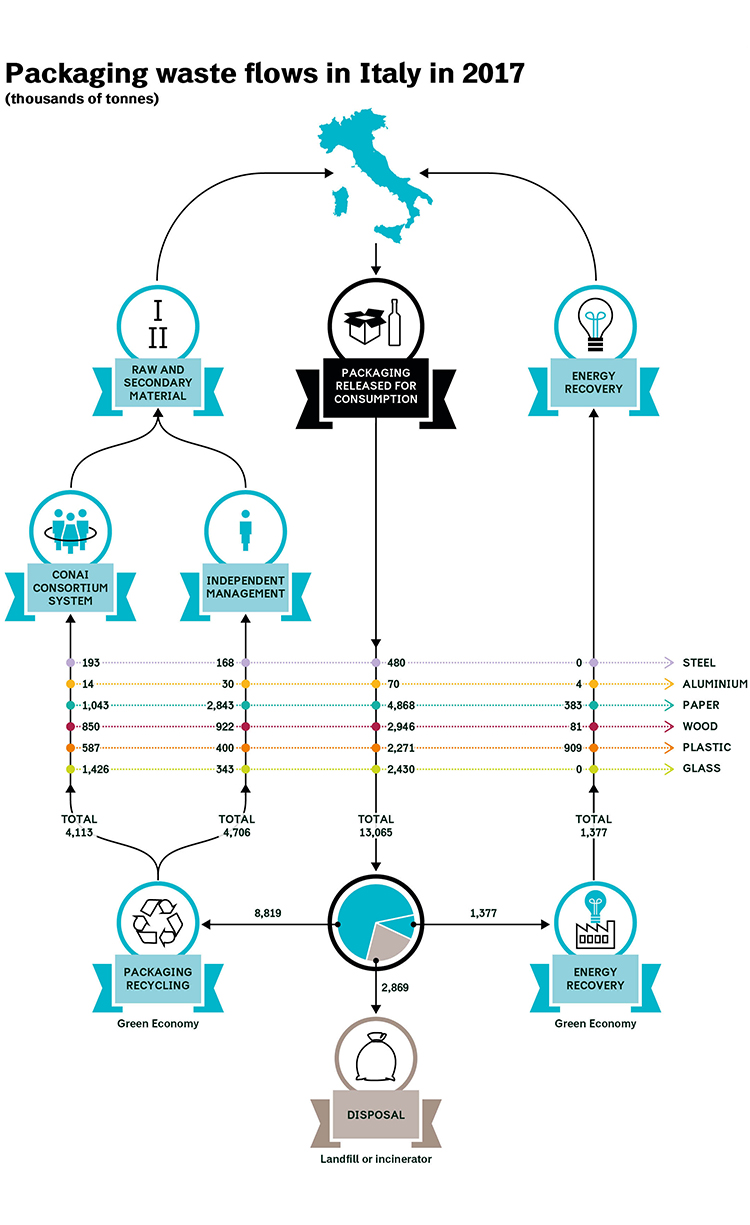
The strong economic contraction that started in 2008 had a strong impact on the packaging sector. Before that time, volumes of packaging released for consumption had been increasing quite regularly, showing a good correlation with the GDP: packaging released for consumption increased by an average of 1.7% from 1998 to 2008, a growth rate that was very similar to the one observed for the GDP (1.6%). The financial market crisis that started at the end of 2008 has had strong repercussions on real economy, causing a great decrease in both industrial production and internal consumption: in 2009, a 5.1% GDP decrease was accompanied by a 13% decrease in packaging released for consumption in Italy. After a period slow and uncertain growth, consumption started rising quickly after 2013, reaching pre-crisis levels by 2017. This was caused by an economic recovery (albeit bland) and the growth of online purchases, that modified the characteristics of packaging with an increased use of secondary packaging for single units, which then become waste for the final consumers and therefore entering the circuit of urban separate waste collection.
The materials used to manufacture the packaging have not changed much during the years, and have mostly involved the use of cellulosic materials, which represented 37.3% of material released for consumption in Italy, followed by wood with 22.6%, glass with 18.6% and plastic with 17.4%, whilst steel represents 3.7 and aluminium 0.5%
More than 10 million tons of packaging waste have been recycled and used for energy recovery in 2017. This is equal to 78% of the amount released for consumption, well beyond the objectives dictated by law and progressively increasing in the course of the years. These numbers are the result of twenty years of work in the consortium system with the mission (past and present) to abandon a management model based on the use of landfills. A mission that can be considered as accomplished since the use of landfills for packaging waste in Italy went from 67% to 22% from 1998 to 2017, as well closing the gap with other large European countries, except Germany, that shows a relevant quota of energy exploitation with a marginal use of landfills as well as excellent recycling performances.
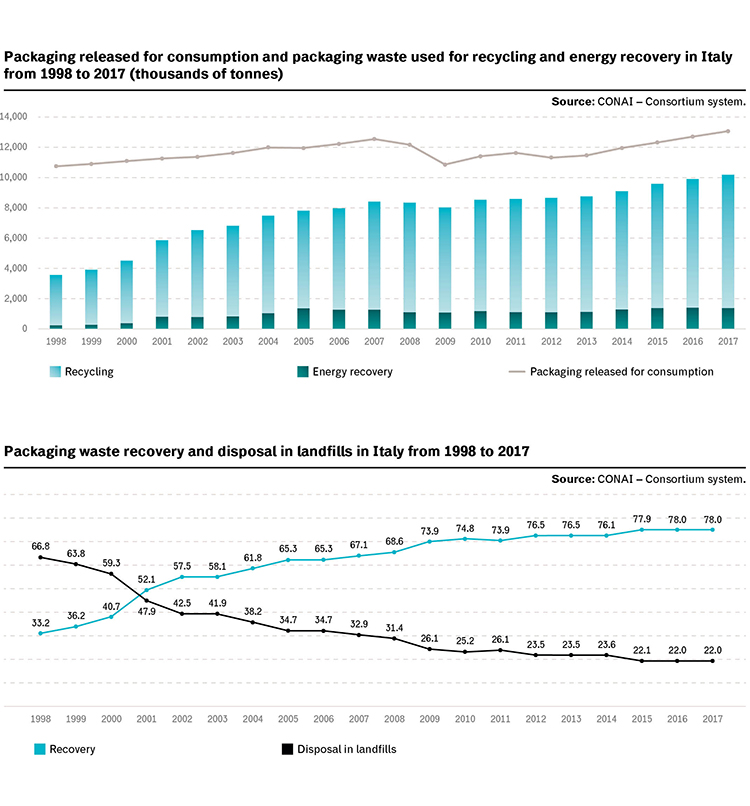
Approximately 8.8 million tons of packaging were recycled in Italy in 2017, the equivalent of 67.5% of packaging released for consumption. The numbers have tripled since 1998, with steel, aluminium and plastic showing the most promising trends. The main component consists of cellulosic packaging, which is 44% of the total recycled material; glass and wood are next, both with 20%.
On the other hand, approximately 1.4 million tons of packaging waste were used for energy recovery in 2017.
Before the adoption of Dlgs 22/1997, separate waste collection meant as an instrument to intercept urban packaging and assimilates was not very widespread and the recycling of packaging (nearly exclusively secondary or tertiary) was only guaranteed by independent management operators. Through the activities carried out by CONAI and the six Consortiums since 1998, the quota of municipal waste made up by packaging made with the six materials found its way towards recycling, or towards thermo-energetic exploitation if non-recyclable. The consortium quota rose progressively and went from 188,000 tonnes in 1998 to more than 4 million tonnes in 2017: this past year, consortium management was able to represent 47% of the total recycled packaging waste.
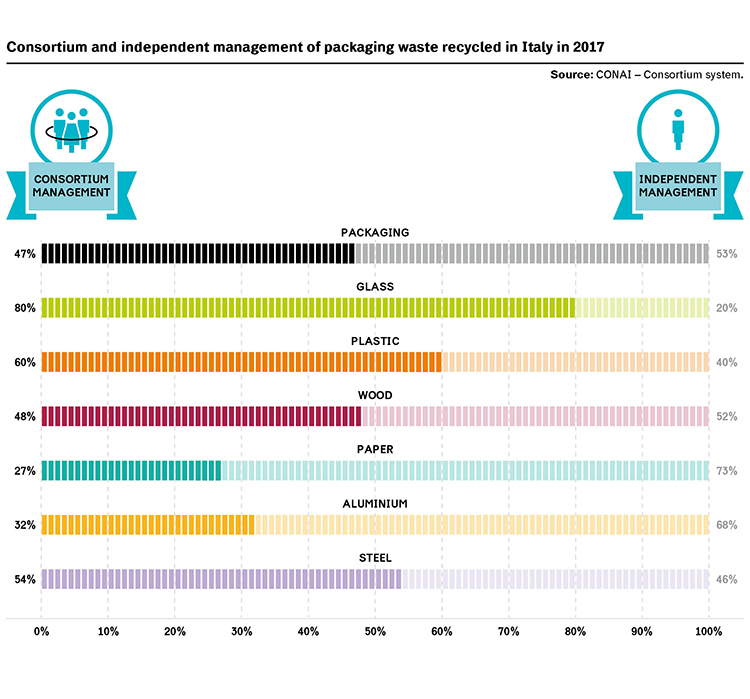
We can positively affirm that recycled quantities have increased through both independent and consortium management. Nevertheless, the former was able to determine the change of pace that took place in the last two decades: more than 70% of the surplus 5.5 million tonnes of waste recycled in 2017 compared to 1998 consists of the recycling managed by CONAI and the Consortiums.
In the last few years, recycling of packaging has grown significantly all across Europe, and this trend must be analysed in order to contextualise the data pertaining to our country. Recycled packaging waste in the European Union went from 47% to 68% from 1998 to 2016 (the last year with available Eurostat data). Progress has involved all member states with few exceptions, even though there are differences in terms of achieved objectives and improvements.
A comparison between Italy and some member states (taking the limits connected to the application of inhomogeneous calculation methods into account) shows that first of all, the starting situation was very different from the current one: especially for Germany, that already showed very high recycling quotas (more than 80%), whilst the levels in other countries were much lower, for example France with 42%, Spain with 34%, Italy with 32% and the United Kingdom with 28%. Important changes take place in 2016, with a strong growth of recycling quotas in major European economies (with the exception of Germany that suffered a 9% decrease, but still stayed at the top of the European rankings).
Our country has shown the most relevant progress: the weight increase of packaging released for consumption between 1998 and 2016 increased by approximately 148%, compared to the European average of 71% (only the United Kingdom showed a greater percentage improvement, but with lower recycling rates compared to Italy).
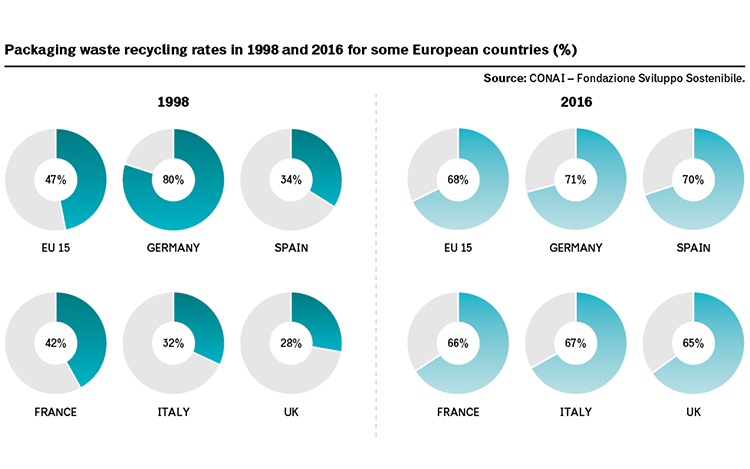
The environmental and socio-economic effects of packaging waste recycling in Italy
The recycling of packaging causes a series of indirect positive effects on some relevant environmental issues, including climate change. A series of activities that allow to re-insert secondary raw material into the market starting from waste, means energy is saved and fewer emissions are released into the atmosphere compared to the activities necessary to obtain the equivalent virgin raw material (from extraction to processing to final transport).
The Life Cycle Costing (LCC) methodology described in the first chapter measures environmental and economic performances of the packaging recovery sector starting from 2005 – the year in which the “Progetto Obiettivo Riciclo” (Objective Recycling Project) was initiates, was expanded to independent management. We wish to underline that the estimates relative to independent management cannot count on certain and high quality data like the ones used for consortium management; this is caused by the hard to trace flows and insufficient detail information regarding technology and processes.
Thanks to the total amount of recycled waste, the consumption of 8.6 million tonnes of virgin raw material was avoided in 2017, showing a 30% increase compared to 2005: thanks to CONAI – the consortium system and independent operators, our country was able to avoid the use of more than 100 million tons of raw material from 2005 to 2017.
The trends for saved raw material in the course of the years follows the ones for recycling. The consortium system contributed to this result with a 44% quota in 2017, increasing ram material savings connected to its activities by more than 50%.
Packaging recycling has generated an accumulation of energy savings equal to more than 500 TWh in 2005, showing a constantly growing trend even during the phases in which the economy slowed down and the quantities of packaging waste released for consumption decreased. Approximately 47 TWh were saved in 2017, the equivalent of 15% of the nation’s energy needs (320 TWh in 2017), 44% of which were saved thanks to the activities carried out by the consortium system. Recycled plastic packaging generated 18 TWh i.e. 38%, paper and cardboard 30%, the equivalent of 14 TWh; glass is next with 7 TWh, wood with 5, steel with 2 and 1 for aluminium. Independent management can account for 60% of the generated savings.
The national recycling system has avoided the emission of 86 MtCO2 into the atmosphere during the same time period, this is the equivalent of the emissions generated in one year by the whole thermoelectric sector. 45% of the avoided emissions come from the recycling of paper, followed by glass with 19%, plastic with 14%, steel (9%), wood (8%) and aluminium (6%).
Last year, recycled packaging waste in Italy has avoided the emissions of approximately 8.3 million tonnes of CO2eq, the equivalent of the annual emissions generated by 2.5 million vehicles with an averaged travelled distance of 20,000 kilometres. Recycling activities carried out by consortium management in 2017 have contributed to this result with a 44% quota, and have more than doubled their contribution to the reduction of greenhouse gas emissions from 2005 to 2017.
The recovery of packaging waste produces important economic and employment benefits for the country system, in addition to the aforementioned environmental benefits.
The economic value of the raw material produced by recycling is estimated around 1.1 billion euros of direct benefits in 2017: 37% of these savings (approximately 420 million euros) can be attributed to the activities carried out by CONAI and the consortiums. These savings have increased with the passing of time thanks to the growth of separate waste collection and recycling of primary packaging, doubling the numbers from 2005 (with a temporary decrease in 2009 caused by a drop in the prices of raw materials).
CO2 avoided thanks to recycled packaging can also be shown in terms of indirect economic benefits, deriving from the reduction of a relevant and negative external environmental effect: we can attribute an economic value using the cost of CO2, which is placed at 30 euros per ton on a European level by Directive 2009/33/Ce. The savings in terms of avoided external effects is equal to 250 million euros in 2017: the activities carried out by CONAI – consortiums has contributed to more than 100 million euros of these savings, whilst the remaining 150 million were obtained through independent management.
The direct benefits connected to the economic value of packaging recycled between 2005 and 2017 amount to more than 10 billion euros, whilst external factors avoided in terms of greenhouse gas emissions are equal to 2.6 billion euros.
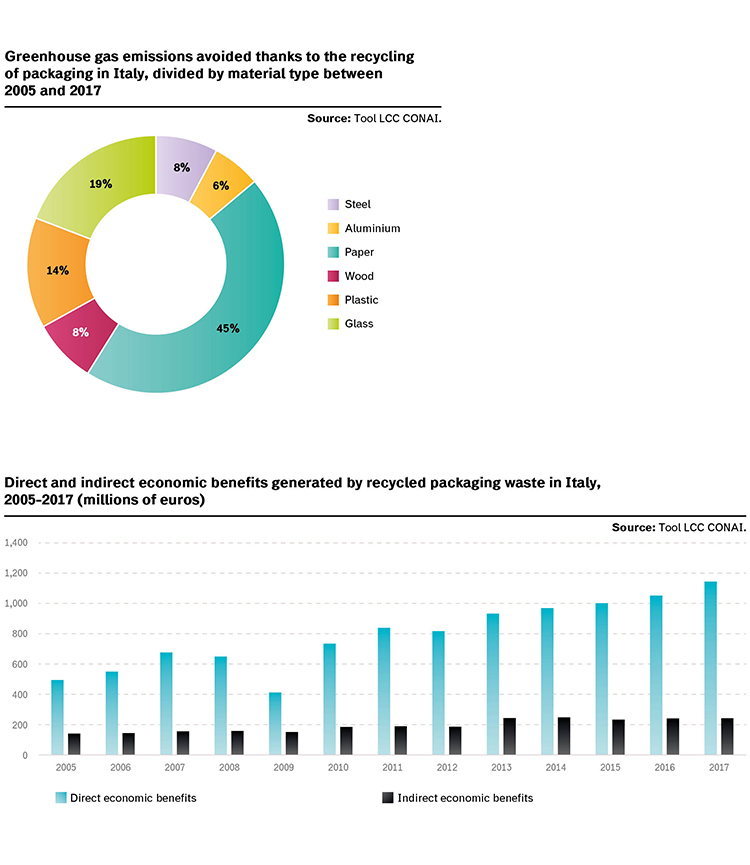
The innovations implemented by the new directives on circular economy for packaging
The new European directives on circular economy marks an important passage for the system that manage packaging waste in Italy, setting new and ambitious recycling targets between 2025 and 2030, both overall and for single industries.
We can affirm that Italy is already on the right track: by reaching 67.5% in 2017, Italy has already surpassed the new European target set for 2025 and is not very far from the 70% objective set for 2030. The objectives for single industries for 2025 have already been reached: recycling for steel has reached 75.3%, paper 79.8%, 72.8% for glass, 63.4% for aluminium and 60.1% for wood.
The percentage of recycled plastic is 43.4% and it is below the 50% target set for 2025 as well as the one set for 2030 (55%). These are ambitious objectives that require greater effort on the part of producers and users in order to increase recyclability, and on the part of recyclers who must strive to improve the technologies they employ.
If we observe Italy’s overall situation, we can see that our country has already surpassed the recycling objective set by the 2025 directive (i.e. 65% of the weight of packaging released for consumption) six years early: in fact, 66.7% of material released for consumption was already being recycled by 2012.
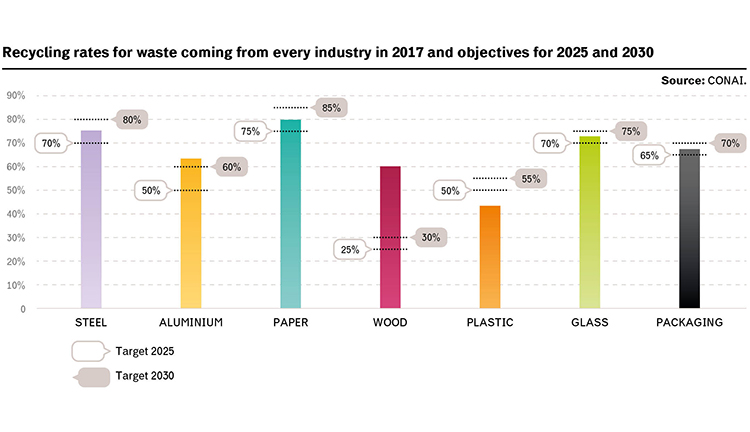
There are still 2.5 percentage points separating Italy from the objective set for 2030 (70%), which has been slowly decreasing over the years (in 2005 Italy was recycling 54% o packaging released for consumption, 16% less than the 2030 target, by 2011 the margin had decreased to just above 5 percentage points with 64.5%).
The new European directive do more than establish new recycling objectives. The new European norms on the issue of waste and circular economy contain other important measures for the transition towards green economy in the waste sector. Such measures include economic disincentives for conferral to landfills and combustion of waste and a rising presence of punctual pricing systems. Economic incentives aimed at stimulating local authorities to promote prevention and enhance separate waste collection are also clearly stated, as well as the measures that support the expansion of the reuse sector and the elimination of and the elimination of subsidies that contrast the waste hierarchy. Public procurements aimed at promoting sustainable production and consumption system are also considered very important, both technical and fiscal measures aimed at supporting the development of reused product markets and recycled materials.
It also tackles the discipline of the Extended Producer Responsibility, defined as one of the main instruments to promote the shift towards a circular economy. The EPR European norm aims at involving producers with the product’s life cycle and in the circular management of its end of life stage in a more effective way, with important direct effects on consortiums that represent the system for the exercise of producer responsibility allowing the achievement of very important goals, especially in Italy. EPR systems will have to ensure that European and national waste management targets are reached, therefore they will have to avoid that the failure to achieve such targets becomes a burden for citizens and that there are no consequences for producers that are part of a collective system. To this end, they will have to ensure that waste producers pay the correct sums to cover the costs of separate waste collection, selection and processing operations information provided to waste holders as well as data and collection and communication. The cost that need to be covered are those of an efficient management system that also includes the quality of separate waste collection, with possible justified derogations for the packaging sector; producers should still cover at least 80% of costs. EPR systems will have to ensure that financial contributions from producers used to cover waste management costs are modulated according to reparability, durability, recyclability and the presence of harmful substances in their products.
The current Italian governance models allows packaging producers and consumers to organise the management of their packaging waste on the national territory in an autonomous manner (also as a collective); join CONAI and one of the consortiums that participate to the CONAI system; assume the responsibility of creating a return system for their packaging.
The choice to divide the system by industry is the natural consequence of the attempt to reach recycling and recovery objectives set by the packaging waste directive, that establishes general objectives for packaging and specific objectives for the different types of materials.
According to comparative studies with other member states carried out by the European Union (EU, DG ENV, Use of economic instruments and waste management performances, 2012) the Italian waste management model was one of the best in terms of costs and achieved objectives. It showed it could react well in critical situations: it was able to absorb the negative effects on the recycling market during the 2008 economic crisis, when the prices of raw material made recycled material less convenient. In fact, the system was able to spur the growth of separate waste collection within municipalities, it incentivised citizens to take part to a responsible consumption style, It grew their awareness on this issue and enlarged the recycling market in our country. The CONAI model obtained indisputable results, it was the EPR model with the best results in Italy.
The performances achieved by the model at the base of the consortium system allow to look confidently towards the future, with the aim of contributing to the shift towards a circular economy.
The efforts of CONAI and the Consortiums goes beyond numbers or future objectives, it is also to continue providing the necessary support in terms of resources and know how, so that Italian municipalities that are still late in the application of integrated waste management systems founded on the exploitation of all product fractions (with a focus on packaging), are able to reach a level of excellence with regards to quantity and especially quality.
It will be important to continue carrying out actions toward consortium members with regards to the main objective in line with the “from cradle to cradle” strategy, starting from the prevention of the environmental impact of packaging from the industry, not only towards local authorities, for the quali-quantitative development of separate waste collection, but most of all to support research activities for recycling technologies.
The prevention of the environmental impact of packaging and the promotion of ecodesign cover an important role in terms of recyclability and the use of secondary raw materials to produce packaging. Following this logic, CONAI’s activities are articulated and will articulate in two large categories:
use of the leverage provided by the CONAI Environmental Contribution as a structural prevention system, that will ensure contributory diversification in the plastic recycling industry according to selectionability, recyclability and the prevalent destination circuit once the packaging has become waste.
Pensare Futuro (Future Thinking) activities to spread provide support instruments for the production of Eco-compatible packaging in companies which are part of the consortium (E PACK service – Guidelines to facilitate packaging recycling activities) and the exploitation in the case of success with a new iteration of the Bando CONAI for prevention.


